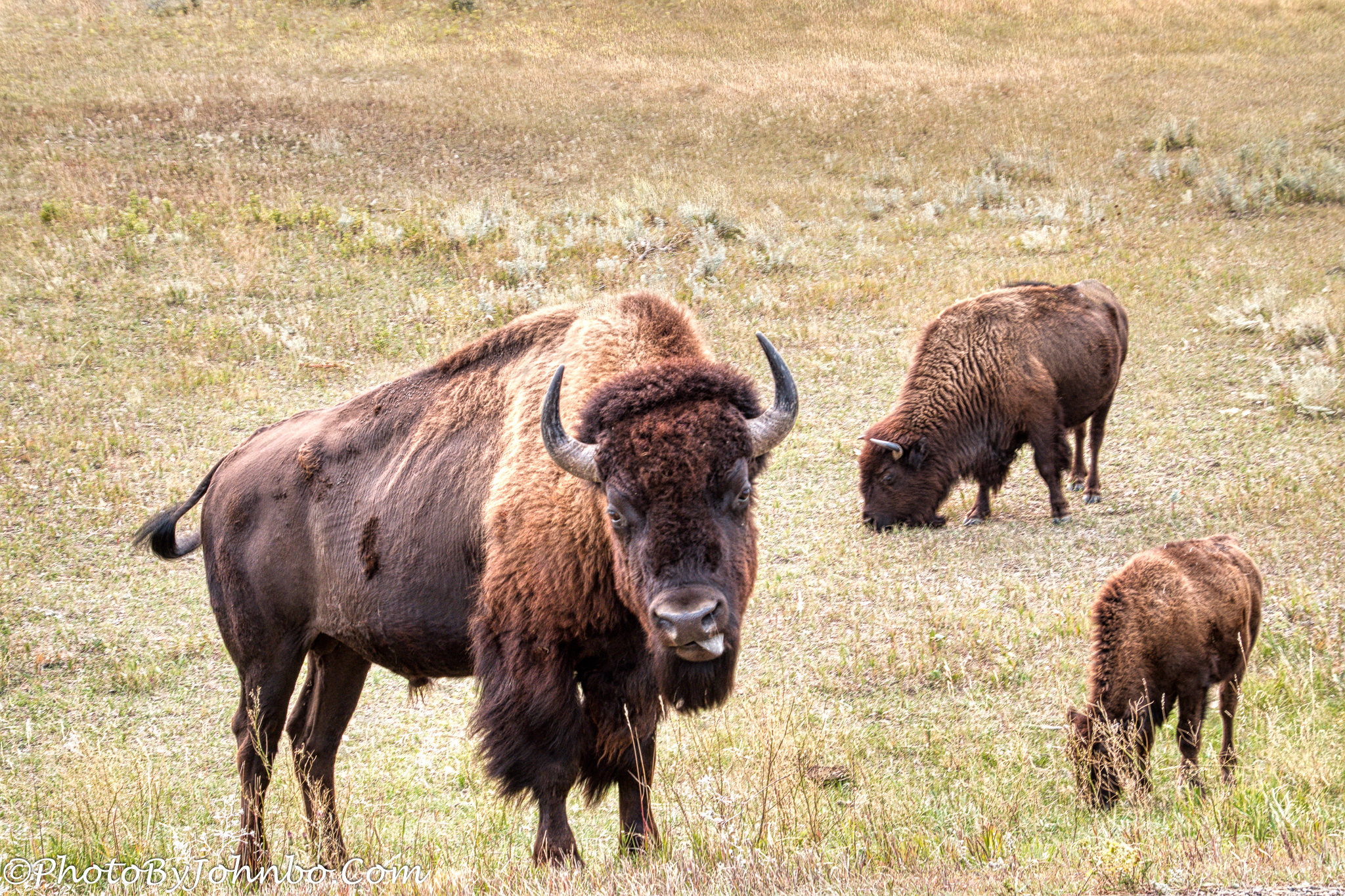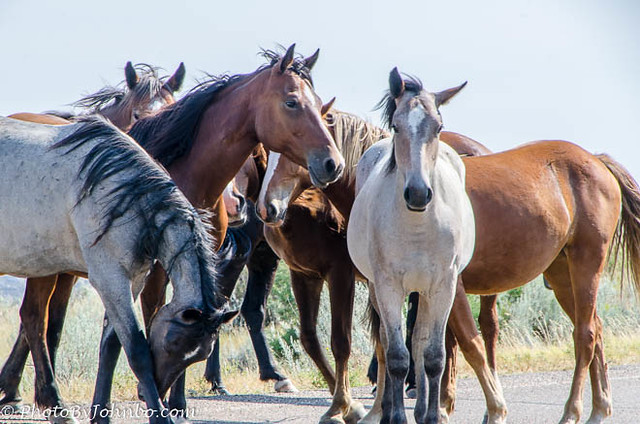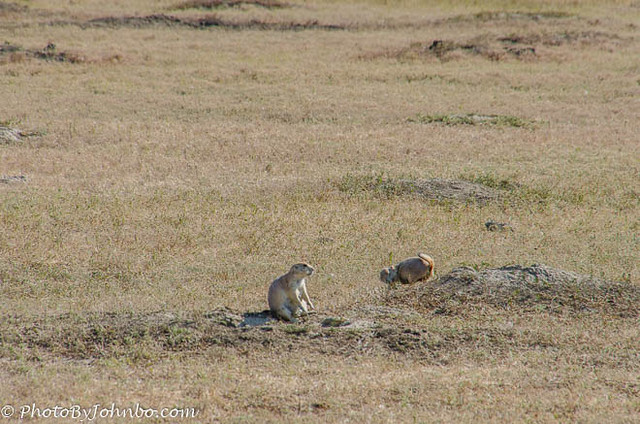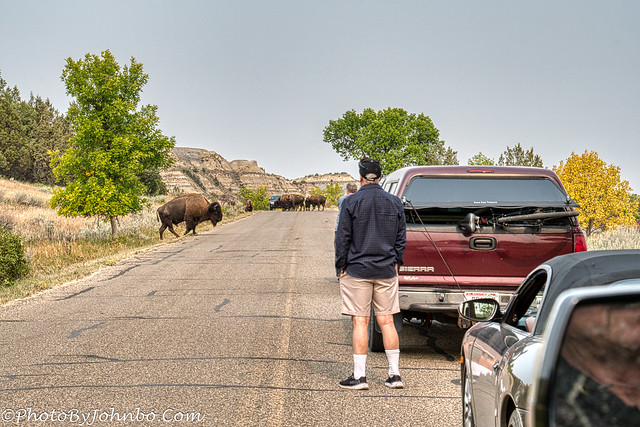Theodore Roosevelt National Park.
Over the years, I’ve had the opportunity to travel through the national park in North Dakota that was named after the 26th President of the United States. For a time, the President lived in my home state on a ranch near what is now his namesake park.
“I have always said I would not have been President had it not been for my experience in North Dakota,” Roosevelt once noted. He first arrived in the Dakota Territory to hunt bison in 1883. The young man from New York would have the future of our country forever changed by conservation policies that were borne of his legacy.
This post, however, isn’t about Teddy Roosevelt. It’s about the descendants of the wildlife that roamed the park when he lived in the area. I’ve gathered the largest gallery of images I’ve ever shared here featuring images of wildlife I’ve encountered while traveling through the park. The opening photo features a bison bull, cow, and calf. The bison bull can be identified by a large tuft of hair on the head and the horns curve upward. Cows don’t have the extra hair on the head, and though you can’t see it in this photo, the cow’s horns curve inward with the horn tips pointing at each other.
The second image features wild horses standing on the main road through the park. As you might imagine, cars stopped and people got out to take photos of these beautiful animals.
Another common resident of the park is the prairie dog. There are several “towns” in the park where these busy rodents entertain the child in all of us. They sit up on their haunches and “bark” at passers by. If you try to get too close, they will scamper down one of the many holes. Walking around a prairie dog town is an invitation to step in a hole or on a weak spot and end up with a broken ankle or worse.
Always remember, we are visitors to these magnificent animal’s home territory. Bison appear to be gentle giants, but they are known for being short-tempered, especially if they might be concerned for the safety of a calf. If you leave your car, keep your distance and stay near your vehicle in case they charge. At least 25 yards (22 m) is a minimum to keep you safe around these animals that can weigh 2,000 lbs (900 kg) and can run at more than 40 miles per hour (64 kph).
Those same 25 yards apply for elk, bighorn sheep, moose, and other large wildlife of the prairie. The bison, though, is by far the park’s most dangerous resident. The rising number of injuries to national park visitors has been shown to be related to the use of cell phones to take photographs. The short focal length of the typical cell phone camera entices people to move closer for a “better shot.”
A study at Yellowstone National Park, another home for the American Bison, tracked 21 visitors and 4 employees injured during the study period.
20 people, or 80 percent, actively approached bison before they were hurt.
5 people, or 20 percent, didn’t back away when bison approached.
15 people, or 60 percent, were hurt when in a group of three or more people who approached bison.
12 people, or 48 percent, were hurt while photographing bison.
6 people, or 24 percent, acknowledged they were too close to bison.
You can read more about the study here.
One of the advantages of moving to Flickr is that I can actually offer you a dynamic slideshow gallery. Though right now, I cannot automatically start the slideshow, I can show you how to do it.
Click on the bison thumbnail below to open the gallery of 30 photos. In the upper right corner of the gallery, you’ll see three icons:

To start the slideshow on the album page, simply click on the leftmost icon.
Alternatively, you can manually click on any image and then manually scroll through the gallery using the arrows on the left and right of each image. I hope you enjoy my views of wildlife in Theodore Roosevelt National Park.
Of course, you can get to the Flickr gallery by simply clicking on any image in this post where you can scroll left and right though the gallery as well.
John Steiner







Nice group of photos. I especially like the photos of the horses. I’ve been to TRNP many times but have very few horse pics. Good work.
I have had similar lack in finding horses on other trips, but fortunately, the last two visits brought me luck.
This isn’t a park I’ve visited (as yet) but I’ve seen bison in Yellowstone and managed to get some decent photos with my zoom lens. It’s crazy that people go as close as they do to such a dangerous animal. I saw similar years ago in the Everglades when a family of picnickers tried to rescue some rubbish that had blown away, right under the nose of an alligator. I know littering is bad, but it’s not worth getting yourself killed for. Luckily they saw sense and retreated in time!
Then there are those people who step backwards off a cliff because they try to take a photo of something a little bit too close for their camera.
One has to keep in mind the dangers of those wild places that are so commonplace that people forget they aren’t at home watching TV.
Yes, very true. And I think you’re right that mobile phone cameras are contributing to the problem, and more and more people try to take photos who maybe wouldn’t have bothered to carry a camera in the past?
John these are all excellent photos but I especially like the Horses and the Bison. Your text commentary has some great advice, too. Best, Babsje
Thanks for the kind words and for taking the time to comment!
Beautiful pictures, John. Thank you.
Thanks!
Thank you so much John for sharing your beautiful pictures.
I enjoy sharing them!